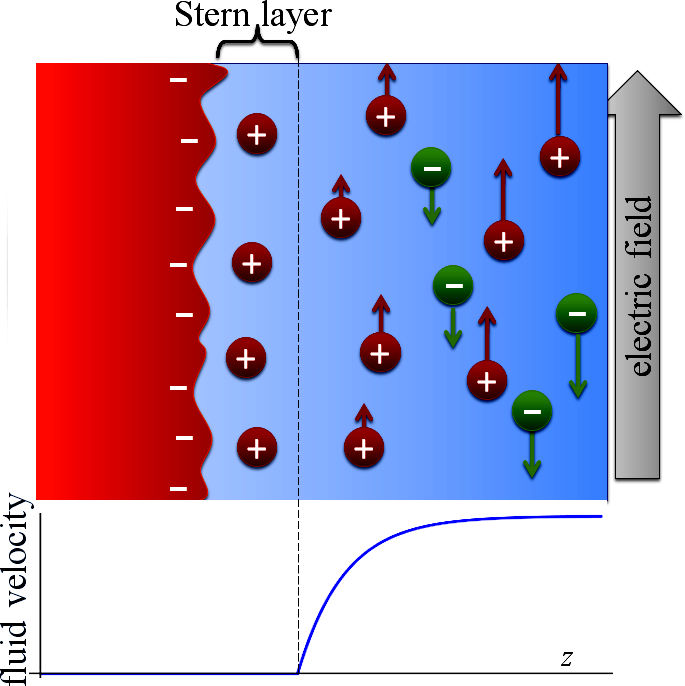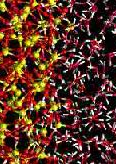electrokinetic phenomena
 The classic picture of an aqueous electrolyte
near a charged surface is shown to the right. The charged
surface, and the oppositely charged counter-ions that compensating the
surface, for an electrical double
layer. Motion of the ions in response to an electric
field causes electrophoresis,
drifting of the ions in response to the field. Near the surface,
there are more counter- than co-ions, so the drifting ions in response
to a field parallel to the surface induces a net flow in the fluid,
known as electroosmotic flow
(EOF).
The classic picture of an aqueous electrolyte
near a charged surface is shown to the right. The charged
surface, and the oppositely charged counter-ions that compensating the
surface, for an electrical double
layer. Motion of the ions in response to an electric
field causes electrophoresis,
drifting of the ions in response to the field. Near the surface,
there are more counter- than co-ions, so the drifting ions in response
to a field parallel to the surface induces a net flow in the fluid,
known as electroosmotic flow
(EOF).
It has long been known that the simplest models (Gouy-Chapman) predict too much EOF. This is one reason why in 1924 Stern proposed that fluid near the surface is immobile. This supposedly stagnant layer is now called the Stern layer. The expected fluid velocity profile near the surface is shown in the figure. Since the effective charge now driving EOF only comes from outside the Stern layer (the diffuse layer), the Gouy-Chapman-Stern theory does a good job describing EOF.
Gouy-Chapman-Stern theory does well for EOF, i.e. motion of the fluid, but it gets into trouble with regard to motion of the ions. It predicts too little ion current. This has led colloid scientists to propose the dynamic Stern model, which says that ions are mobile but water in immobile in the Stern layer.
 Using our microscopic model for the
amorphous silica/water interface, a prototypical double layer
system, (see figure to the left and our other page on the silica water interface),
we have investigated the microscopic basis of electrokinetic phenomena
near silica. We find that a realistic theory can simultaneously
account for both EOF and ion current. The Stern model is really
an effective model that
correctly predicts fluid velocity far from the walls. However, it
cannot be taken literally near the walls. The dynamic Stern
model is not a microscopically realistic picture of the electrical
double layer. It is neither tenable, nor required to correctly
describe both EOF and ion current.
Using our microscopic model for the
amorphous silica/water interface, a prototypical double layer
system, (see figure to the left and our other page on the silica water interface),
we have investigated the microscopic basis of electrokinetic phenomena
near silica. We find that a realistic theory can simultaneously
account for both EOF and ion current. The Stern model is really
an effective model that
correctly predicts fluid velocity far from the walls. However, it
cannot be taken literally near the walls. The dynamic Stern
model is not a microscopically realistic picture of the electrical
double layer. It is neither tenable, nor required to correctly
describe both EOF and ion current.
This research is supported by the National Science Foundation.
some relevant publications
- Wei Zhu, Sherwin J. Singer, Zhi Zheng and A. T. Conlisk, ``Electroosmotic flow of a model electrolyte'', Phys. Rev. E71(4): 041501 (2005).
- A. T. Conlisk and Sherwin Singer, ``Modeling electroosmotic flow in nanochannels.'' BioMEMS and Biomedical Nanotechnology 4:301-330 (2006).
- Hui Zhang, Ali A.Hassanali, Yun Kyung Shin, Chris Knight and Sherwin J. Singer, ``The water-amorphous silica interface: Analysis of the Stern layer and surface conduction'', J. Chem. Phys. 134(2):024705 (2011).